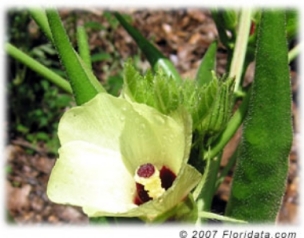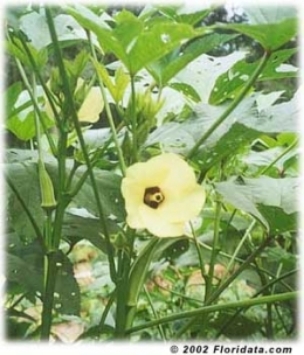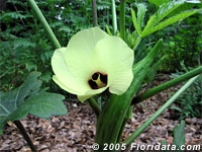Abelmoschus
esculentus
Common
Names: okra, gumbo, gombo, ladies
Botanical
Family: Malvaceae (mallow Family)
 |  |
An okra blossom
rests beside a pair of big fuzzy
ready-to-harvest pods.
| July's heat and
humidity bring okra pods to peak
perfection at the
Florida A&M University Community
Garden in
Tallahassee, Florida.
|
DescriptionA
member of the hibiscus family, okra is an annual that gets 3-8' tall
(depending on the cultivar) and bears yellow flowers that give rise to
the familiar okra pods so valued in Cajun gumbos. The plant is a rather
coarse annual with large lobed, slightly spiny leaves and a thick,
semiwoody stem with few branches. The flowers are showy: hibiscus-like
with pale yellow or cream colored petals and purplish hearts. Okra
blooms and produces over an extended season, usually until first frost.
Cornucopia
II lists 25 varieties of okra available from American seedsmen. They
come in green, pale lime, purple and red pod colors. Some are adapted
especially for northern climates, even performing well in southern
Canada. Some are dwarf varieties, suited for small gardens; some are
spineless and some are velvety until cooked. The standard American okra
is 'Clemson Spineless', accounting for some 90% of commercial
production, and serving the home gardener well for many decades.
LocationOkra
is native to the Old World tropics (probably West Africa) and has
become established in the wild in some New World tropical areas. It is
generally believed that okra first reached the New World during the
days of slave trafficking. Okra is a popular and important food in
Third World tropical countries. It is widely used in India, Africa and
the Middle East, but almost unknown in Europe and northern North
America.
CultureLight: Full sun for
best production.
Moisture:
Keep fast growing okra well watered.
Hardiness: USDA
Zones 5-11. Okra is a hot weather annual. Don't even think of planting
your okra seeds until summer has arrived and the nights stay above 55°
F. Best growth occurs when soil temperatures are above 65°F. From
seedling to first harvest takes only about 60 days, however. If your
warm weather growing season is shorter than that, start the plants
indoors, setting out after all danger of frost has passed, and maybe
even use a cold frame on the cooler nights.
Propagation: You can
speed up germination if you soak okra seeds in water for 24 hours
before planting. Sow seeds about a half inch deep in one long row or in
rows 3 ft apart, and thin to 12 or 18in between plants.
UsageOkra
should be picked every 2-3 days before the pods become tough and woody.
This usually means before the pods exceed 5" in length, although size
doesn't really matter: it's the age of the pods rather than their
length that determines if they are too woody and stringy to eat. Use
your thumbnail to test for tenderness. Even if you aren't going to use
the okra, picking every other day encourages continued production. Cut
the pods off on the stem with shears or a knife; don't cut off the caps
as this will cause them to "bleed" and become slimy. Use okra as soon
as possible after harvesting and do not store in the refrigerator. In
tropical climates, it is common to cut back mature okra plants to the
ground for a second flush of growth and pod production. Be sure to side
dress with a balanced fertilizer.
Our favorite way
to eat okra is to lightly sauté the fresh pods (including the caps and
a short length of the stem) in olive oil, then eat all but the cap and
stem. This way they are NEVER slimy. Our other favorite way to eat okra
is cut up (without the caps) and cooked in a pot with sliced tomatoes
and onions. Okra for gumbo is cut into sections (the caps discarded),
and the sliminess acts as a thickener. Okra is also dried and powdered
to use as a thickener. Many southerners like their okra dipped in
batter and deep fried. This also eliminates the sliminess. Okra is also
great pickled; use the recipe for cucumbers that comes with the
supermarket pickling spice. Okra seeds removed from pods too mature and
woody to eat can be boiled, baked, ground into meal for bread or tofu,
or used as a coffee substitute. In India, the pods are dried, sliced
into sections, and then fried for a crunchy, almost breadlike snack. We
freeze okra whole, with the caps and a short length of stem, to use
later in gumbos, soups and stir fry. Just keep adding more fresh pods
to the freezer bag until it's full, then take 'em out as you need them.
okra
flower and pods

Okra flowers
resembles those of its close cousins the
hibiscus and
rose-of-sharon. Okra pods can be seen
below and to the left
of the
blossom.
FeaturesOur
favorite way to eat okra is to lightly sauté the fresh pods (including
the caps and a short length of the stem) in olive oil, then eat all but
the cap and stem. This way they are NEVER slimy. Our other favorite way
to eat okra is cut up (without the caps) and cooked in a pot with
sliced tomatoes and onions. Okra for gumbo is cut into sections (the
caps discarded), and the sliminess acts as a thickener. Okra is also
dried and powdered to use as a thickener. Many southerners like their
okra dipped in batter and deep fried. This also eliminates the
sliminess. Okra is also great pickled; use the recipe for cucumbers
that comes with the supermarket pickling spice. Okra seeds removed from
pods too mature and woody to eat can be boiled, baked, ground into meal
for bread or tofu, or used as a coffee substitute. In India, the pods
are dried, sliced into sections, and then fried for a crunchy, almost
breadlike snack. We freeze okra whole, with the caps and a short length
of stem, to use later in gumbos, soups and stir fry. Just keep adding
more fresh pods to the freezer bag until it's full, then take 'em out
as you need them.
Okra is low in calories and high
in vitamins A and C and in calcium, iron and protein. Properly
prepared, it is delicious and not at all mucilaginous or "slimy."
Americans rank okra as one of their least favorite vegetables.
Apparently they haven't had whole okra sautéed in olive oil, or pickled
okra, or a big pot of tomatoes, onions and okra stew, not to mention a
New Orleans seafood gumbo!
WarningMany
people get an itchy (but short-lived) reaction from the little spines
on the leaves and stems of okra, and should therefore be careful when
working in the okra patch. Wear gloves and a long-sleeved shirt if you
are bothered. However, even highly sensitive individuals do not get the
reaction from eating okra.
Photos |  |  |
Okra in Community Garden at Florida
A&M University
| Okra Blossom
| Okra
Blossom and Pod
|